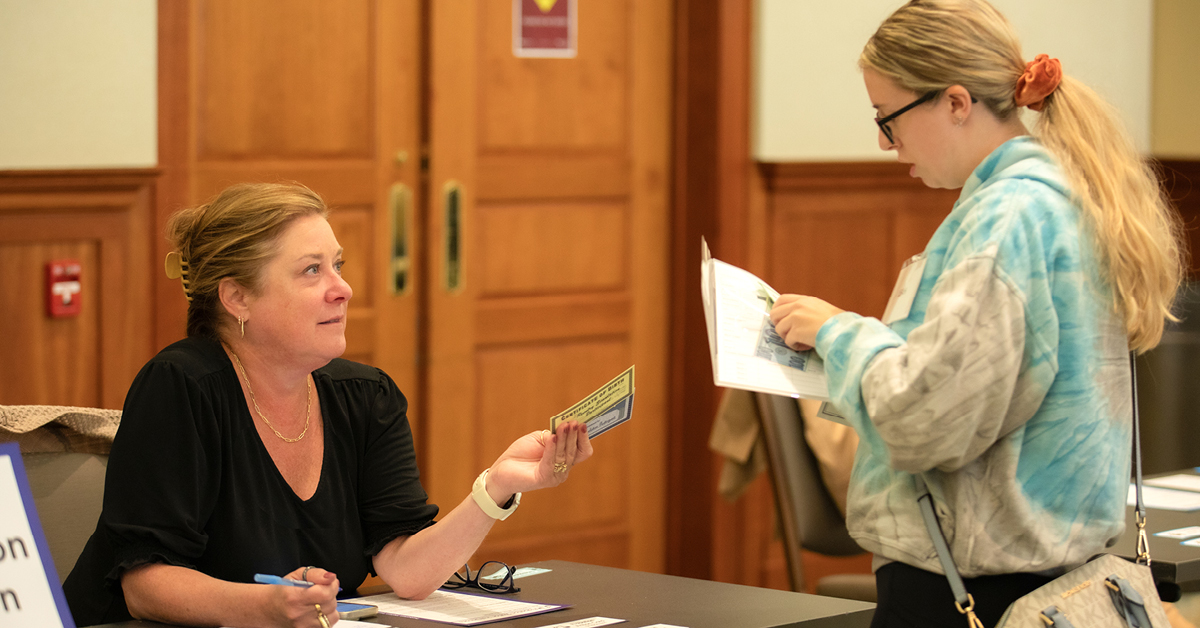Gaining perspective: In simulation exercise, students experience challenges faced by those leaving prison
Gaining perspective: In simulation exercise, students experience challenges faced by those leaving prison

Donnell Bey is eyeing a career in law enforcement.
But earlier this month, the tables were turned on Bey, a sophomore law and justice studies major at Rowan University.
He was among 60 students and other University community members who participated in a prisoner reentry simulation event, presented by the U.S. Attorney’s Offices for the District of New Jersey and the Eastern District of Pennsylvania, along with the College of Humanities & Social Sciences and the Department of Law & Justice Studies.
As part of the one-hour simulation, each student assumed the persona of someone recently released from prison. They spent four “weeks” (actually 15-minute intervals) pursuing services from volunteers representing 14 social service and state agencies.
View a video of the simulation here.
Representing everything from the court system to a treatment center to a medical clinic to a pawn shop to a local church and a host of services in between, volunteers were stationed at tables around the Eynon Ballroom of the Chamberlain Student Center. One volunteer even served as a police officer who “arrested” participants that violated probation or committed crimes.
To simulate real-life situations, participants could make progress, but then hit obstacles. For instance, if participants didn’t find housing by the end of each week, they ended up in a homeless shelter. If they lost their identification, they would have to wait in long lines to get a new one.
Bey assumed the persona of Jose Jones, who was released from prison after completing a 25-year sentence for murder. He was tasked with reassimilating into society with a conviction on his record, $100 in his pocket, no driver’s license or birth certificate and a list of “must do’s” that included meeting with his probation officer, submitting to drug testing, attending treatment and counseling, paying restitution to the court, finding food and searching for a job.
When challenges mounted—he failed drug tests, got thrown out of treatment and never actually looked for employment—he took a chance and sold drugs twice. He was caught the second time and landed back in jail.
“Committing the crime was the easy part,” Bey said. “I failed when I took that chance.”
‘This resonated with me’
The simulation gave Bey, who serves in the Army National Guard, the opportunity to experience, just for an afternoon, the challenges former prisoners face when they enter society. Given his interest in a law enforcement career and in community policing, the simulation was eye opening, he said.
“I was definitely getting nervous standing in the long lines and waiting,” he said. “In my career, I’ll definitely think back to this. This resonated with me.
“My goal in law enforcement isn’t to just put people who commit crimes in jail. I want to take things case by case while doing my best to serve, ensuring people have the resources to be model citizens and excel at reentry.”
According to statistics from the U.S. Department of Justice, each week, more than 10,000 formerly incarcerated individuals are released from state and federal prisons. More than 650,000 are released annually. Of those, approximately two-thirds are rearrested within three years of their release and more than half land back in prison.
According to the Office of the Assistant Secretary for Planning and Evaluation, principal adviser for the secretary for the U.S. Department of Health & Human Services, at any one time 6.9 million people are on probation, in jail, in prison or on parole in the U.S.
That’s why reentry programs and services are so critical, noted Cyndi Zuidema, director of reentry and prevention programs for the United States Attorney’s Office for the Eastern District of Pennsylvania.
“We see this as an investment in public safety,” Zuidema said. “It really is the right thing to do.”
‘It was clear our students took this very seriously’
Zuidema and colleague Mia Lamb, a reentry specialist for the USAO-EDPA, led a lively debriefing session after the simulation.
“What was surprising? Frustrating? What felt unfair?” Zuidema asked the students. “Imagine hitting pause 15 years ago, going to prison and coming out. There’s a lot of confusion, a lot of lack of control.”
Students said they felt that acutely.
“They were taking me through all of these hoops. I finally gave up. I was exhausted,” a student said.
“It felt overwhelming,” another said.
Added a third: “If this was a real-life situation, it would be really difficult. A lot of us were so stressed.”
Wazir Muhammad, who completed the ReNew Court reentry program in Camden after serving 22 years for bank robbery and carjacking, told students he began working toward reentry as soon as he went to prison.
“To me, reentry started upon entry,” said Muhammad, who learned carpentry, plumbing and drywall in prison and, upon reentry, became a certified electrician.
“This was a good simulation to show you how easy it is for a person to give up,” Muhammad told the students. “You can really do an injustice to yourself through bad decision-making. I was determined to turn my life around. My motivation was that I felt like a failure. It was an embarrassment. I’m striving to be the best me.”
Law & Justice Studies Professors Kimberly Houser and Christine Saum organized the simulation at Rowan. It was so successful that they plan to offer it again in the spring.
With an enrollment of 800 students, Law & Justice Studies is the largest major in the College of Humanities & Social Sciences.
“Our hosts from the Eastern District Court are doing this work all over the country,” Houser said. “We wanted our students to learn what the barriers are for people leaving prison. It was clear our students took this very seriously.”